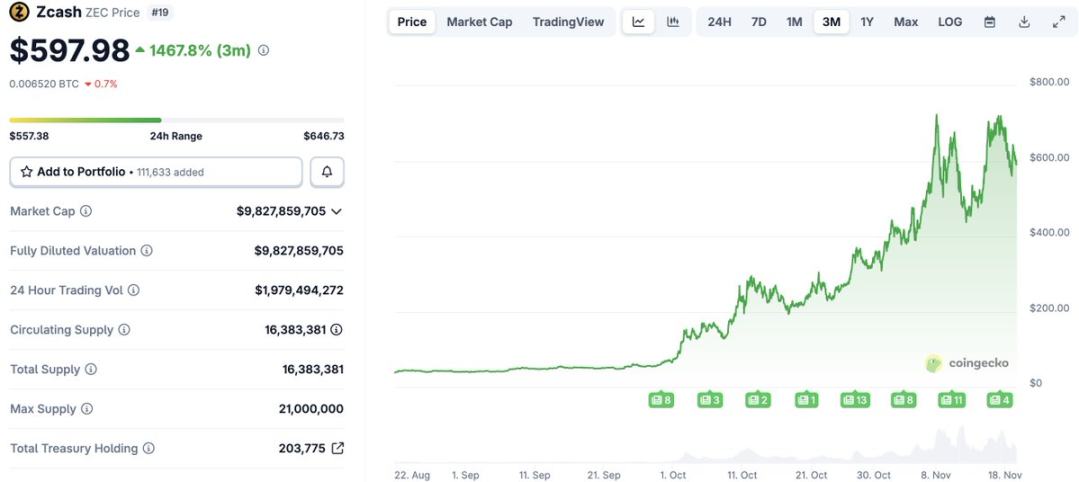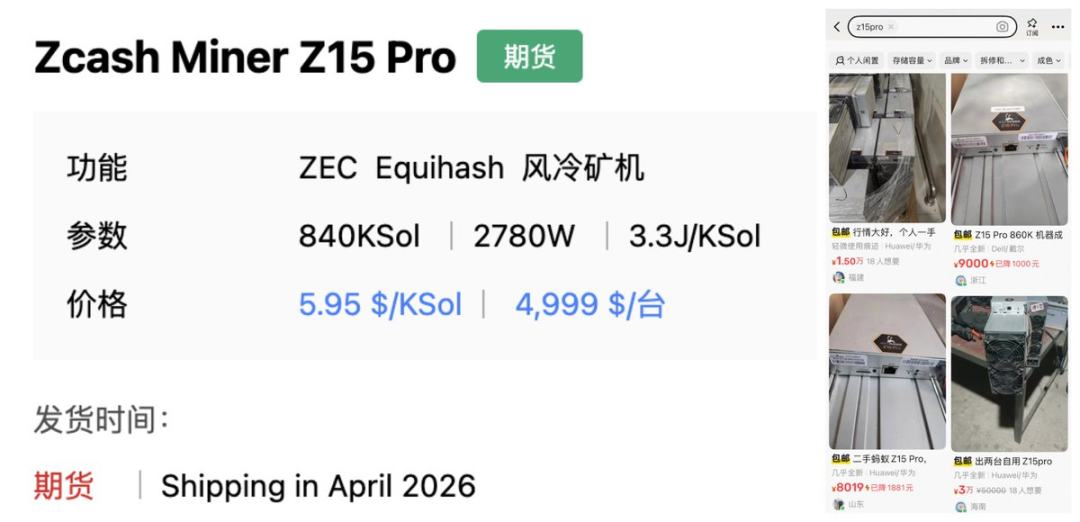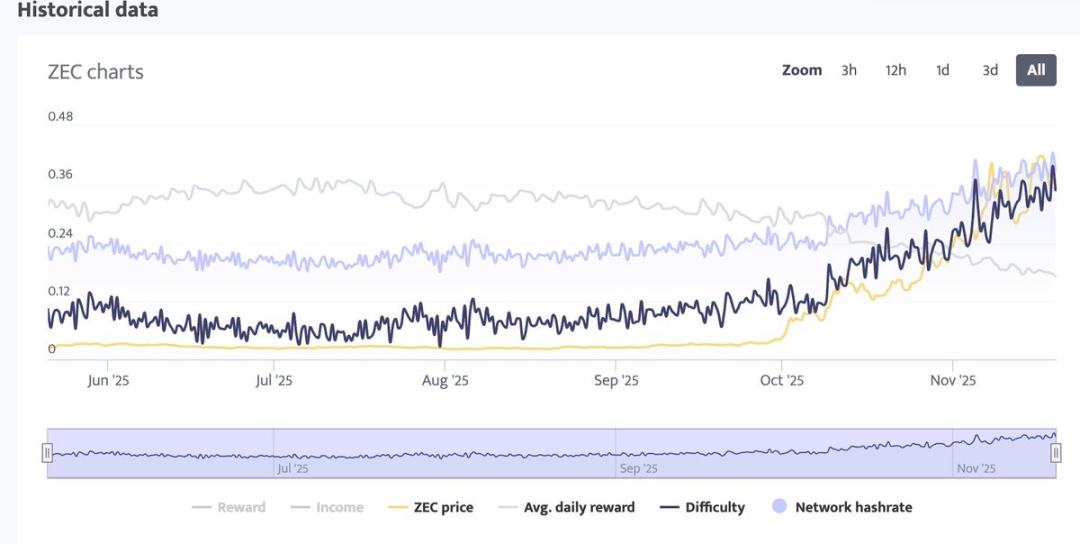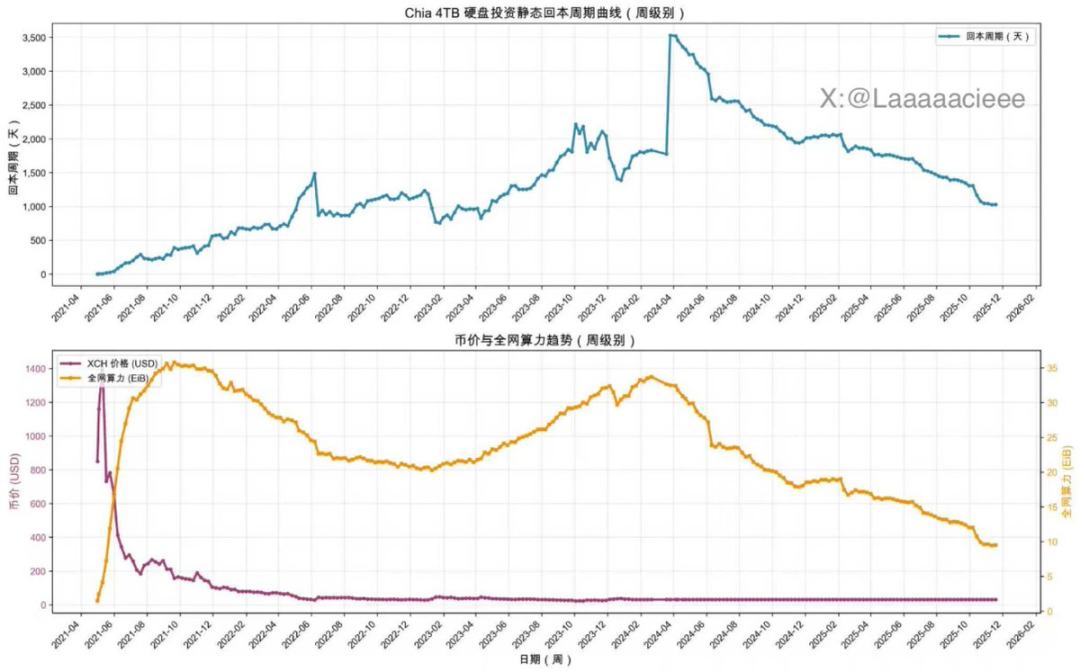Narratives and emotions can create myths, while fundamentals determine how far those myths can go.
Written by: Lacie
The Starting Point of Myths, the Prelude to Collapse
In just the past two months, Zcash ($ZEC) has become the most dazzling focus of the entire crypto market. From a surge to $50 at the end of September to a recent high of $730, the increase has reached an astonishing 1460%, with the FDV skyrocketing to a historical peak of $13B in 8 years.

https://www.coingecko.com/en/coins/zcash
What further heightened the sentiment was the endorsement from several top figures: the calls from heavyweight personalities like @naval, @0xMert_, and @CryptoHayes acted as catalysts, igniting market FOMO and prompting many KOLs, retail investors, and even some funds to reassess this old chain. Rarely, both Chinese and English CT communities have been fervently discussing ZEC, the privacy narrative, and the resurgence of ZK technology, with Privacy seemingly being hailed as the "next big trend" in the crypto market once again.
However, beneath this seemingly hot and perfect narrative, some key fundamental issues have been consistently overlooked: Is ZEC's miner economic model, network security, and on-chain interaction activity truly sufficient to support an FDV of over $10 billion?
ZEC is on the eve of a typical Hardware–Price Scissors scenario in PoW history
Before discussing the sustainability of any PoW project, the economic incentives on the mining side often reflect the chain's value capture ability most intuitively.
Let’s first calculate ZEC's current payback period:
1) Z15 Pro: The Most Mainstream Mining Machine
The most discussed and sought-after flagship ZEC mining machine currently is the Bitmain Antminer Z15 Pro, with the following hardware specifications:
Hashrate: 840 KH/s
Power Consumption: 2780 W, actual operation around 2560 W
Energy Efficiency Ratio: 0.302 KH/W
Currently, the official website only has futures for the Z15 Pro, with delivery in April 2026, priced at $4,999. Those who can't wait can also purchase second-hand stock on the black market, with real prices around 50,000 RMB.

https://m.bitmain.com/zh/product/detail?pid=00020251112140439260bFAoSY2F0667
2) ZEC's Hashrate and Mining Revenue Structure: Astonishing Daily Earnings
In the past two months, ZEC's high returns have quickly attracted hashrate into the market, with the overall network hashrate beginning to grow significantly, and difficulty has entered a rising cycle. The chart clearly shows that ZEC's price (yellow line) began to break away from a sideways trend at the end of September, while hashrate (light purple) and difficulty (dark blue) rose in sync. This trend indicates that the mining side has started to respond to the price increase.

https://minerstat.com/coin/ZEC
As of the time of writing, the key parameters of the Zcash network are:
Total Network Hashrate: 13.31 GH/s
Network Difficulty: 118.68M
Block Reward: 2.5 ZEC / block
To calculate daily earnings, we input the Z15 Pro's parameters into a mining revenue calculator, using standard miner settings:
Pool Fee: 2%
Electricity Price: $0.08 / kWh
Daily Power Consumption: $5.34 (2.78 kW × 24 hours × $0.08 / kWh)
We can then arrive at an astonishing figure: the net earnings of a single Z15 Pro exceed $50 per day! Historical data shows that such high earnings have persisted for at least a week.

https://whattomine.com/coins/166-zec-equihash
3) Payback Period: Extremely Rare High ROI
Assuming the network difficulty remains stable in the short term and electricity costs are steady, we calculate the payback period using the Z15 Pro mining machine futures price of $4,999.
To reflect the true cost, we amortize the mining machine over 5 years (1826 days):
Daily Machine Cost Amortization: $2.74
Daily Net Earnings After Amortization: Approximately $47.63
Thus, the static payback period for a Z15 Pro is only about 105 days, translating to an annualized return rate of nearly 350%.
This figure is extremely rare in the entire history of PoW—one could even say it is anomalous:
The payback period for BTC mining machine upcycle typically ranges from 12 to 24 months
The ROI for ETH during the PoW era was between 300 to 600 days
Historically, PoW projects with payback periods under 120 days (such as FIL, XCH, RVN, etc.) have almost all collapsed within months

The latest BTC mining machines yield about $23 per day, with a static payback period of approximately 3.4 years.
4) Case Review: The Repeated Hardware–Price Scissors
The Hardware-Price Scissors is a recurring "harvesting" script in PoW mining history, where miners order mining machines at a premium price when the coin price is at its peak and FOMO sentiment is strongest (at this point, ROI appears extremely low, with a payback period of only 4 months). However, when the machines are actually delivered and the hashrate surges (usually delayed by more than 3 months), the whales often sell at high prices, leading miners to face a double whammy of "coin price halving + output halving," turning their mining machines into overpriced scrap metal.
- In May 2021, Chia caused a global shortage of hard drives. At that time, the price of XCH soared to $1,600, and the static payback period for early hard drive investments was once compressed to under 130 days. This extreme profit quickly triggered a tsunami of global storage hashrate. However, what followed was a brutal "scissors gap": despite the drop in coin price, the hard drives ordered earlier continued to come online, and the overall network hashrate still surged after the coin price peaked, with the payback period rapidly extending from 30 days to over 3,000 days.

- Observing the data of the IceRiver KS1 mining machine, in mid-2023, its payback period once dropped to 150 days. Unlike Chia, the price of KAS even maintained an upward trend. However, even so, miners still faced losses because the rate of hashrate growth far exceeded the rate of coin price increase. The rapid iteration and large-scale deployment of industrial-grade ASICs led to an exponential rise in overall network difficulty. Despite the coin price remaining strong, the payback period for the KS1 machine still irreversibly soared to 3,500 days.

ZEC's hashrate level is currently in a historically dangerous range that has been attacked by 51% multiple times
Beyond the mining economic model, another decisive risk line is the network's security and hashrate scale. For PoW chains, the "total network hashrate + 51% attack cost" directly determines whether it can remain self-consistent at a high valuation.
1) Total Network Hashrate: Equivalent to a Small to Medium-Sized Bitcoin Mining Farm
According to the latest network data, ZEC's total network hashrate is approximately 12.48 GSol/s. Based on a Z15 Pro's hashrate of 0.00084 GSol/s, it would require about 14,857 Z15 Pro mining machines, with corresponding energy consumption around 40 MW, which is equivalent to the scale of a small to medium-sized Bitcoin mining farm.
From the perspective of the entire network's hashrate scale, Zcash's security foundation appears extremely weak, having entered the risk range of many small PoW chains that have been successfully attacked by 51%.

https://miningpoolstats.stream/zcash
2) Attack Cost: Theoretical Level of Only a Few Million Dollars
Generally, launching a 51% attack requires controlling over 50% of the network's hashrate at the same time. If nearly 16,000 Z15 Pros can form the main force for ZEC, then an attacker would only need to rent or purchase a few thousand devices to potentially control over 50% of the hashrate.
A rough estimate:
The cost of each Z15 Pro futures contract is ~$5,000, and generally, purchasing over 300 units qualifies as a large customer order, which can enjoy at least a 10% discount.
Controlling hashrate with ~8,000 units → maximum cost of ~$40M, with the energy consumption required for an attack around 20 MW.
If leasing or second-hand prices are lower, the actual startup cost could be in the millions of dollars.
On a public chain with an FDV nearing $10 billion, a potential chain reorganization or double spend can be initiated with just a million-level hashrate investment, which itself is a structural risk that cannot be ignored.
3) Comparison with Mainstream Chains: Huge Security Gap
To provide a more intuitive and clear perception, let’s make a simple comparison with other large PoW chains currently in operation:

More critically, ZEC's current hashrate is not only far below mainstream PoW chains like BTC/LTC/KAS, but even chains like ETC, BTG, VTC, and BSV, which have been successfully attacked by 51%, had higher hashrates during their attacks than the current ZEC. This means that ZEC's network security has effectively fallen into a dangerous range where it can be attacked.
On-chain data reveals that ZCash's actual usage remains very limited
Despite the recent rise in the ZEC narrative, on-chain data provides a more sober perspective—there is a significant deviation between actual usage and the current multi-billion FDV.
From transaction volume, active addresses to ecosystem scale, Zcash's actual network activity is far from the prosperity implied by the price trend:
The average daily transactions over the past month were only 15,000 – 18,000 transactions per day, accounting for only 1% – 2% of large public chains.
As a privacy chain, the vast majority of transactions are still transparent, with shielded transactions accounting for less than 10%.

https://zechub.wiki/dashboard
Repricing when the market returns from frenzy to calm
Narratives, emotions, celebrity effects, and mining machine economic traps have collectively pushed an eight-year-old dormant project to the peak of public opinion. But through the bustling surface, when we truly return to the three core aspects of blockchain: economic sustainability, network security, and on-chain adoption, ZEC presents a completely opposite picture.
This is:
A mining environment with a payback period of only 105 days and an annualized return of 350%.
A hashrate scale equivalent to a medium-sized Bitcoin mining farm, with a 51% attack cost as low as the million-dollar level, transaction volume only 1%–2% of mainstream public chains, and actual usage of privacy features accounting for less than 10% of a PoW chain.
History has proven countless times: extremely short payback periods (super high ROI) are often precursors to mining disasters and price crashes.
Whether ZEC will be an exception, I cannot assert.
But the rules of the crypto world have never changed: narratives and emotions can create myths, while fundamentals determine how far those myths can go.
免责声明:本文章仅代表作者个人观点,不代表本平台的立场和观点。本文章仅供信息分享,不构成对任何人的任何投资建议。用户与作者之间的任何争议,与本平台无关。如网页中刊载的文章或图片涉及侵权,请提供相关的权利证明和身份证明发送邮件到support@aicoin.com,本平台相关工作人员将会进行核查。




